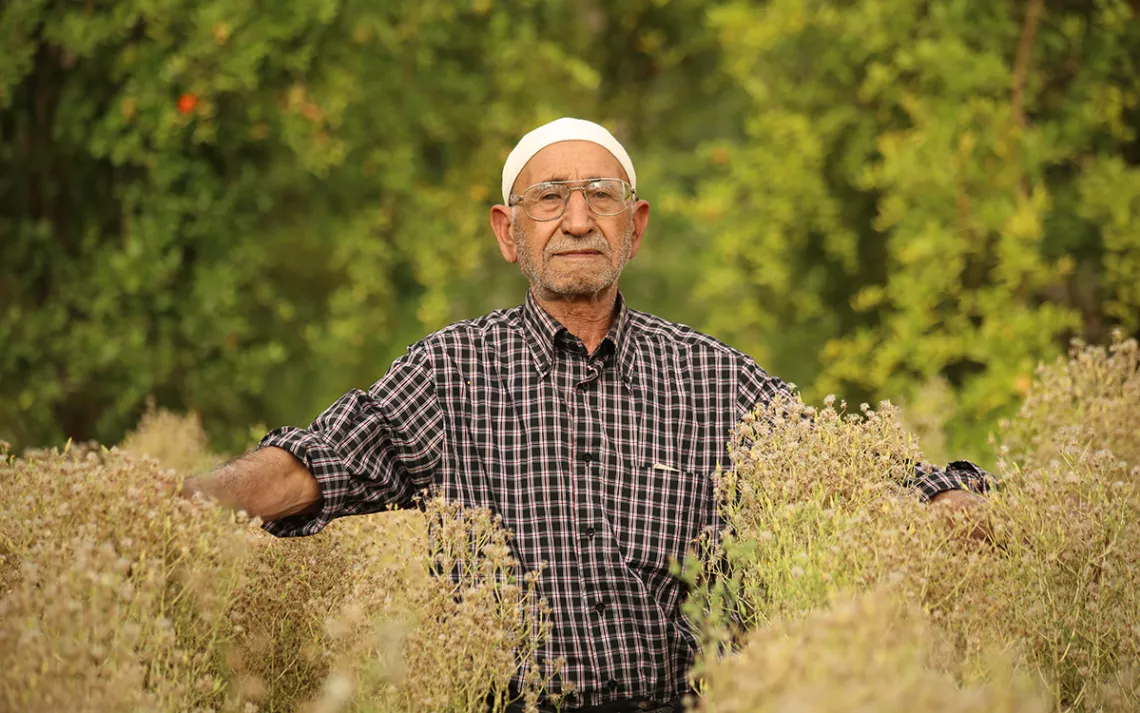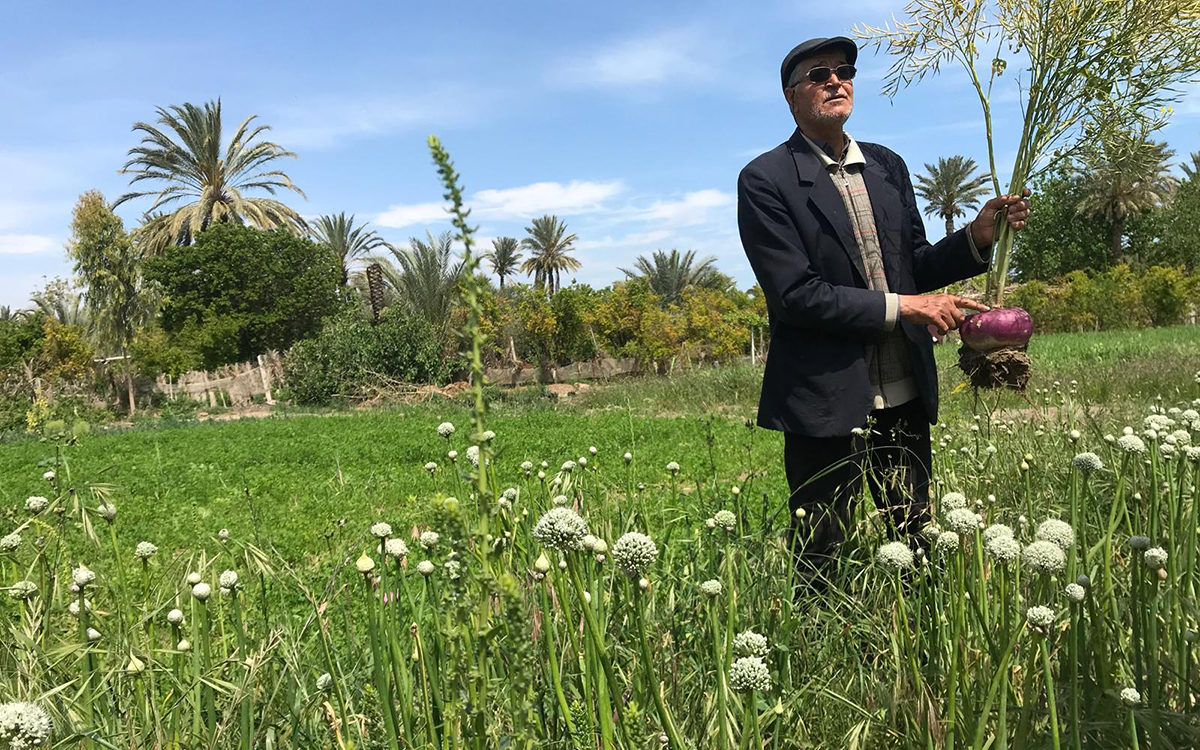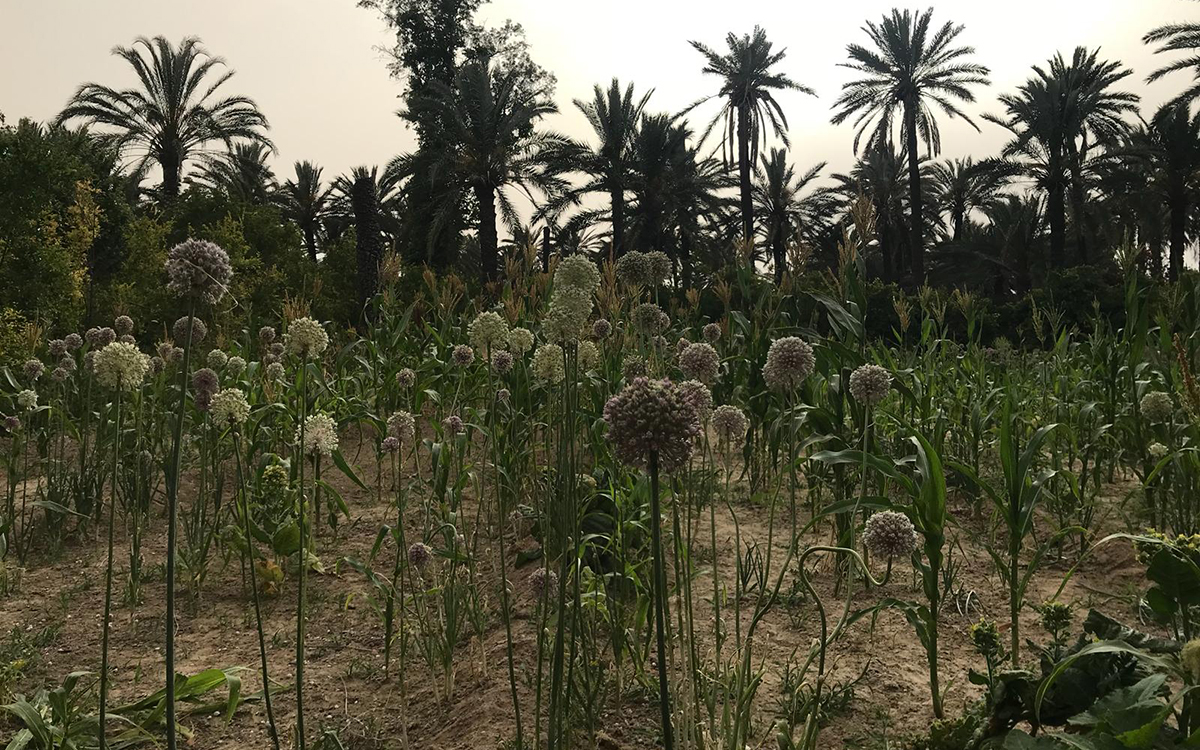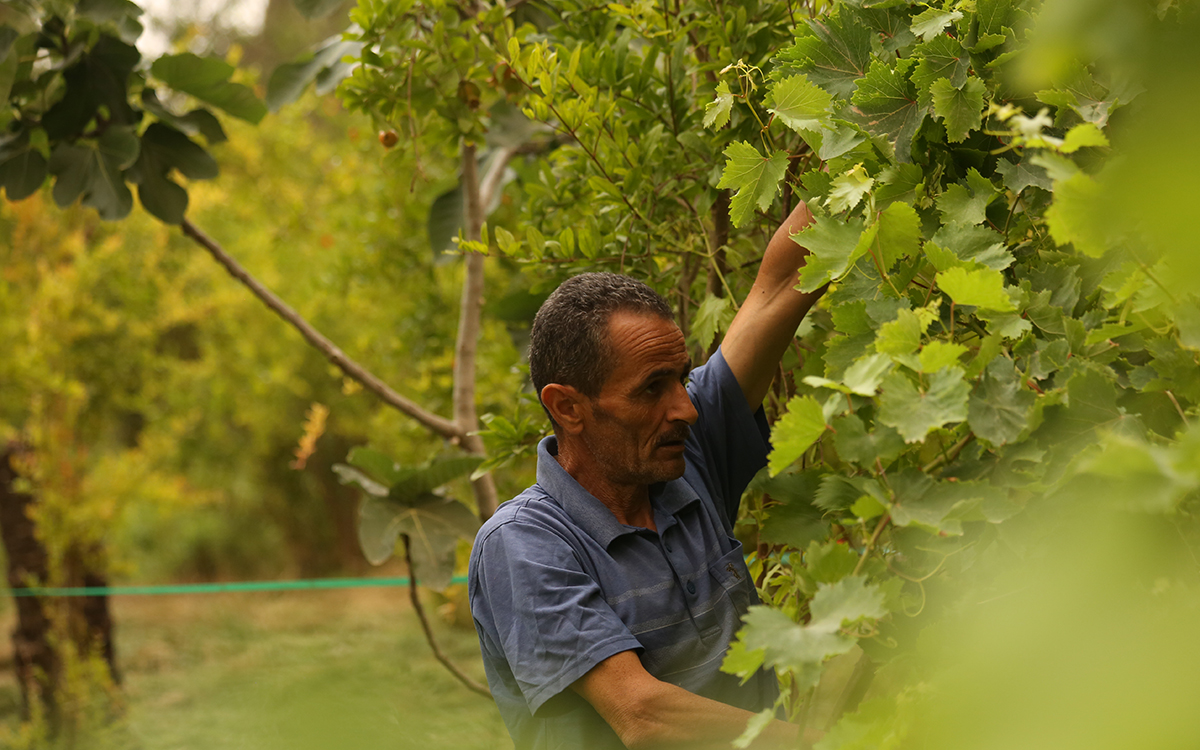Agricultural Time During a Pandemic
In search of circular time under lockdown

In the second half of January, I met a friend in Tunis, the capital of Tunisia. He was agitated and said that he needed to go back to his hometown of Gabès. “Now, now,” he said, chain-smoking, his foot tapping under the cafe table. Time was running out.
He said he needed to plant trees. It was that time of the year, when temperatures are mild at night and cold in the day—the ideal climate for planting fruit trees. It’s known as the layali essoud. As a local saying puts it, “layali essoud, yanbet fihoum kol oud” (during dark nights, every stem will grow). For 18 days and nights, my friend told me, farmers cut leafless branches off dormant pomegranate, fig, and peach trees, snip stems from the bare grape vines that hang overhead, and plant them in the earth.
In March, I followed my tree-planting friend to Gabès. A few days later, the country went into lockdown to stop the spread of the novel coronavirus. And so, I became a guest in a ghabba.
The word ghabba means “forest” in Tunisian Arabic. But it also means a plot of farmland within an oasis. The ghabba that I passed my time in was a hectare of land (around 2.5 acres), much of it overgrown with reeds. It was a 10-minute scooter ride from where I was staying in town and five minutes from the bus station, but you wouldn’t know it. Rows of palm and fruit trees blocked the traffic from view, and cars avoided the narrow pathways.
I didn’t look for a way to leave. I was ready to replace humans with plants, and the uncertainty—of the world, of my life—with the work of making things take root.

Abdejellil Chaabane grows produce and flowers for making scented water. | Photo courtesy of Layli Foroudi
The Tunisian traditional agricultural calendar splits the year into unequal slots of time that indicate how crops behave and what activities to carry out. Layali essoud comes just after layali el bidh—the white nights from December 25 to January 13 when temperatures plunge in the night. “The plant sleeps, so it is the time to cut it—it doesn’t hurt them,” explained Hassen Waja, a 74-year-old retired teacher, when I arrived in Gabès. Waja grew up on his family’s farm in the Menzel oasis. Now he shuttled between his home and the ghabba, tending to the fruit trees that had been a livelihood for his family but were a hobby to him.
It was the same for many of his neighbors. The next ghabba over was tended by a barber. Around the corner, Abdejellil Chaabane, a retired chemical plant worker grew the largest beets I had seen in my life and flowers that he used to make scented water. Other plots were abandoned or overgrown with reeds, a perfect cover for discreet gatherings to drink the alcoholic date palm drink dead legmi.
The coronavirus hit Tunisia on March 9 at the start of hssoum: seven windy days in March that signal the transition into spring and the time to pollinate the date palms. To do so, I reached up and cut off bundles of the powdery white male flowers, which grow in a formation that could have inspired Marie Antoinette’s bouffant. Then I carried them to the other side of the garden and tied them into the bunches of flowers growing on a female tree. The female genes are dominant no matter which type of male date palm pollinates her. Today, many people don’t bother pollinating their dates—it is a lot of work to climb the tree, and there isn’t much of a market for local date varieties. I managed to pollinate only one, which was short enough to reach while keeping my two feet on the ground.
In Gabès, dates came up often in my conversations with those aged over 50. “We didn't eat yoghurt and biscuits for breakfast; we walked to school with dates in our pockets,” another retired oasis returnee, Abdelhamid Lahbib, told me. (The Gabès way of bashing millennials is calling them the “yoghurt generation.”) Back in the day, dates were the go-to food for breakfast or a snack, and Gabès-grown dates were bought in bulk by nomads because they travel well. Now it is the sweeter deglet nour variety, mass-produced for export in a neighboring region, that is sold on the street for those wishing to break the fast in the style of the Prophet, with one date or three.
The demise of the local date has transformed the oasis, said Nizar Kabaou, whom I met at the organic compost station around the corner from my adopted ghabba. Kabaou runs the station as part of his work for the Association for the Preservation of the Chenini Oasis. “The farmer hasn’t found a solution for the palm tree,” said Kabaou. “It doesn’t bring me anything. It is not profitable.” There are farmers that think like this now.” Since the 1970s, he said, Gabès has seen a 60 percent reduction in the surface area covered by date palms.
*
Gabès is unique in the world. It is the only oasis that borders the sea, mountain, and desert. The 14th-century travel writer Mohamed Attijani remarked that only in Gabès could you find fruit, seafood, and dates on the same table. People say that the region used to be renowned for its silk, which came from worms that resided in the mulberry trees. Many of those trees were burned during various conflicts over time, and the silkworm no longer exists here.
Now, it is the smell of sulfur that is a marker of home. Before the countrywide lockdown, as my train approached the town, two other travelers caught a whiff and each other’s eyes across the carriage. “We’ve arrived!” they said, laughing grimly. Since the 1970s, the region has served as a zone for the treatment of phosphate, a key natural resource for the country, used for the production of fertilizers—an irony given the devastating effect the industry has on local agriculture.
In Gabès, many people complain about the lost opportunity for the tourism industry. During the lockdown, the sulfur smell faded temporarily after the partial closure of the factory by the virus. Tourism, people hoped, would help the local economy and would not result in the same air pollution and the tons of phosphogypsum waste in the sea. “Water used to flow all the way down here—tourists used to stand in this place, take photos and say ‘Wowww,’” a farmer named Zakaria Hechmi, told me, pointing to a Roman aqueduct not far from his ghabba in the Chenini Oasis. But the mass tourism that boomed in other Tunisian coastal cities leaves its own type of scars on the landscape: the gigantic hotels wearing away beachfronts, the vast swimming pools drinking up groundwater in the dry high-season months.
In the Chenini Oasis, I met a taxi driver, out of work for the time being due to COVID-19, who was tending to rows of carrots, beets, and lettuce. In normal times, his 20-year-old son, a mechanic, rarely helped out—maybe once a month—because he wanted to go to the cafe with his friends and “make the most of my youth.” But with cafes and shops shuttered, industries closed and travel banned, the oasis had become a primary occupation again—a place to pass the time and to eat.
In another ghabba, sauntering among plants almost his height, I met Aam Salah, 80 years old, smiling, wearing a red hat. He stopped beside a giant flower that he told me is a lettuce. His garden is mostly vegetable plants that, as they bloom to produce seeds, look like aliens. Most oasis farmers, he said, have forgotten the art of seed harvesting since imported varieties were introduced in the 1960s.
Back then, many farmers took up the free seeds offered to them by businessmen. But Salah was wary. The new varieties didn’t flower, which meant no more seeds. “It was safer to keep our own seeds and to look ahead,” he said. “They are free, but it might be their strategy that one day they wait until you only use their seeds, and then they will increase the price and you won't be able to do anything.” The small cabin on his ghabba had three rooms: one with a bed for when he wanted to spend the night instead of returning to his house, a kitchen area where he made strong tea, and a third room filled with local seed varieties. In hssoum, he didn’t have much to do, he said—most of the seed harvesting happens in June and July. “The season is changing. Forty-five days after hssoum, take off your clothes and swim!” he said, citing a local proverb. Spring is here, and summer is coming.

In Aam Salah’s ghabba, plants have gone to seed. | Photo courtesy of Layli Foroudi
In the Tunisian traditional agricultural calendar in between layali essoud and hssoum on February 14 is a very cold night called garaat al anss, the “war of the goat.” “We say that the goats cannot survive this night because it is so cold,” Mabrouk Jabri told me while wading through his flooded lettuce fields. According to local folklore, the day is named as such because of a goat-herding farmer who had two wives, one in Tunis where he spent winter and one in the south, where he would return in spring, when the trees start to flower. His southern wife, apparently unhappy with this arrangement, hatched a plan to get him home. In the middle of winter, she chose a peach tree—the first to give fruit in the oasis—and fed it warm water to simulate spring. After some time, the tree started to flower, and so she snipped off a few flowers and sent them to her husband. He received the missive and, assuming spring had come, gathered his goats and headed south. But the winter chill meant that the goats didn’t survive the journey.
Whether the story is true or not, the earth now seemed to be playing the same trick. Rising heat is stunting the local grapevines, which need to chill to properly grow, and is causing havoc with fruit trees in the oasis. Male and female fig trees are maturing out of sync. In Jabri’s plot, a big fruit tree gave him two or three edible apricots last year because it flowered before its time. “When we find a tree like this, we say, “She is dreaming!” he said. “A tree with fruit in February is dreaming, because it is not the season to do that. If you have a beautiful patch with apricots, figs, all flowering before their time, then you know, c’est raté.”
But the biggest disturbance to the oasis rhythm is still the nearby cement and phosphate treatment plants, which have exhausted the region’s natural water resources. The ecology of the Tunisian oasis is traditionally made up of different stories, which create a microclimate. Palm trees provide shade for fruit trees, which create shade for vegetable gardens and livestock. In the 1970s, as the water became harder to get, many farmers pulled out their fruit trees to make way for henna, a drought-resistant crop that, in the days when it was more lucrative, saved livelihoods.
*
When I first met Jabri, water up to his ankles, surrounded by lettuce heads, it was the least convenient time for him to talk. It was his turn for the water that used to stream through the oasis between the rows of trees and vegetables, providing irrigation for farmers and swimming spots for children.
Now the water comes every 40 to 50 days and costs three to five dinars per hour ($1 to $1.7), plus a five to 10 dinar bribe for those who want to skip to the head of the line. “Before the creation of the industrial zone, the oasis benefited from 750 liters of water per second—from a natural source. Now we are at 150 to 170 liters per second, with a pump. That is the ecological catastrophe that Gabès has undergone,” said Jabri, annoyed—maybe because of the water situation but also likely because of my asking him questions during these crucial few hours of irrigation.
During the lockdown, a rumor began to spread that the spring, Ain Badha (“white source”) had started to flow again, owing to the almost complete closure of the industrial zone. I traveled to the source in Ras el Oued, a scooter ride away from Chenini, with Jabri’s 30-year-old nephew, Khaled, who is part a local movement called Stop Pollution.
In theory, Khaled told me, with the water-intensive industrial activity on pause, natural sources should regenerate in a relatively short period. In 2011, the revolution that toppled dictator Zine el Abidine Ben Ali caused the industrial zone to shut for six months and temporarily resurrected Ain Badha.
But when we arrived at the valley, there was no motion. Though there was more water than usual, Khaled thought it was probably rainwater. “A river flowed through here, but now it’s a swimming pool of mud,” he said, speaking about something he was too young to have ever seen in person. The cracked clay crunched below our feet as we walked along the riverbed.
*
In some parts of Tunisia, people still count their days according to the agricultural calendar, though this is rare now. In Gabès, only the farmers still use it, said Waja, the retired schoolteacher. When Waja was a child, he said, “the oasis used to be life.” Everyone in it lived according to the schedules of plants. Waja’s family, like most, had a house in the oasis and a house in the town. Back then, they rarely left the ghabba. “We lived here all the time because it was practical. We did agriculture all year and bought nothing,” he said.
Neighbors exchanged vegetables, he said, but also sometimes tried to steal each other’s water, resulting in a system called tafra, whereby his whole family and some others would do an all-nighter every two weeks to make sure no one would intercept the water before it arrived the next day. Kids from five or six families would regularly get together for raghata, where they would list chores to carry out collectively, like maintaining the water canals. The same band would set off together in the mornings to walk into town for school.
Ninety-five percent of the population of the Chenini Oasis were full-time farmers, according to Nizar Kabaou. Today, about 20 percent are. But 40 percent still practice agriculture in their spare time, and, in the past five years, Kabaou has seen a small renaissance of part-time oasis farming, which has only grown during the lockdown. “This period gives value to the old type of agriculture,” he said. “To live, we need to do our own production. In situations like this, we need to be self-sufficient.”
This old type of oasis farming was marginalized after Tunisia gained independence from France in 1956. New state policies focused on the development of large agribusiness with an emphasis on export, at the expense of small-scale agriculture. Plots of land surrounding the oasis were bought by investors, and with the help of government incentives, transformed into fields of olive and fruit trees. “There is something about agriculture in Tunisia,” another farmer, Zakaria Hechmi, told me. “Who has money, we give him more money so that he can work. Whereas the small farmer, we don’t help them work.”
The notion that oasis farming is not profitable is both an objective reality—small farmers are marginalized by agricultural policy—and it is an excuse used to stigmatize small farmers in order to liberate land for large ones, says Habib Ayeb, a geography professor at the University of Paris 8 in Saint-Denis and the president of the Observatory for Food Sovereignty and the Environment (OSAE). Trained at a Tunisian agricultural college and engineering school in the 1970s, Ayeb remembers being told Tunisia was underdeveloped, because the land was being farmed by peasants who are poor and ignorant. During one college field trip, he stood in a field of wheat with his classmates while two small airplanes flew overhead and sprayed them with chemicals. “We received the modernity in our lungs,” he said.
While I waited out the quarantine in Gabès, the pandemic was disrupting these global networks of food production, with catastrophic consequences. Acute food insecurity is projected to double in 2020, to the point where it will affect 265 million globally. In Tunisia, the economic toll of the lockdown sparked protests in parts of the country where people were struggling to eat.
This did not happen in Gabès, where the ghabba remained. “In Chenini, you never go hungry,” said Hechmi, who still trades produce with his neighbors. “There is always something in the garden. In the summer, there are no vegetables, because there is no water, but then we have figs, grapes, so there are other things.”

Zakaria Hechmi | Photo by Mahdi Khmili
Early on in lockdown, a friend in London messaged me to say she was feeling “despondent about the future.” I asked whether about her own, or the world’s. Both, she replied. “What is the meaning of value of this time and anything done during it?” she wrote.
I had myself thought about how to be “productive” at this time. I had come to the oasis with a stack of books, the intention to perfect my Arabic, and to paint a lot. But, regardless of my future, the world’s future, and my still-broken Arabic, planting felt productive. When you plant, you are literally a producer.
One day as I was pulling out some wild plants that were crowding my onions and herbs, I stopped and checked my phone. An editor for a newspaper I write for had emailed to say that they now had a moratorium on freelance commissions—their page numbers were in free fall due to an advertiser exodus. Hundreds of journalists were losing their jobs. I returned to the soil, to the promising scatter of green leaves leading down to onions. In some places, the purpling-white bulbs bulged just above the ground.
While pruning, I forgot productivity. I thought of how I appreciated the weeds, despite the disturbance they were causing the onions. It made me think of a quote that I read at university by the Russian author Yevgeny Zamiatin:
Yes, without me time and space would freeze into crystalline perfection.… It is I who troubles the waters. I trouble all things. I am the spirit of life.… If it had not been for me, man would be a needless gardener, pretending to cultivate a weedless garden that grew right because it couldn’t grow wrong.… Think of it.… Perfect flowers! Perfect fruits! Perfect animals! Good Lord! How bored man would have been! How bored!
I wrote about this to my Russian literature professor, who was quarantined in her home in London. She sent me the essay that contained it, “Paradise” (1921), and reminded me that the quote I’m thinking of was Zamiatin quoting H.G. Wells quoting Satan. She wrote that she was healthy, but that, since she was in a high-risk group, she was going to be in isolation for a significant length of time. She was hoping the weather would improve so that she could go into her tiny garden.
At the oasis, I also read Flights by Olga Tokarczuk, In one chapter, a character describes two types of time. “Sedentary peoples, farmers, prefer the pleasures of circular time, in which every object and event must return to its own beginning, curl back up into an embryo and repeat the process of maturation and death.” Linear time, which is “able to measure progress towards a goal or destination, rises in percentages,” was more favored by nomads and merchants.
Anthony Aveni, an American anthropologist, attributes the linearization of time to the Christian “idea that we all move forward to the day of reckoning, after which, for those who live the good life, there will be eternal bliss.” When the Black Plague, another pandemic, struck Europe in the 12th century, mechanical clocks were just starting to be installed on town halls and churches. Religious authorities exhorted citizens to pay heed to the new technology: “Watch the clock carefully: You could be experiencing your last hour!”
But for much of history, civilizations have measured time by the beat of the tides, the coming of the rain, the moon, insects. This struggle to box and manipulate time to our will and in service of an imagined human progress has, writes Aveni, “had the effect of removing us from any real involvement in the rhythm of nature.” During my quarantine, seeing the disruption and degradation of the oasis reminded me of this, and of the rising temperatures killing crops globally, seas swallowing islands, and animal viruses leaping across to humans in places where wild areas had become big farms.
At first, it made sense to think of Tunisia’s agricultural calendar as a circle, in that its activities are dictated by nature’s year. Then I began to think perhaps a spiral is a better image, since farmers, even in keeping to tradition, add to their knowledge of the land and improve their practice. When I arrived at my friend’s ghabba, only a portion of the land was still being used to grow fruit and vegetables. Gradually, we began to plant more and clear away reeds that hadn’t been touched in 25 years. No one had the time, and then we did.
 The Magazine of The Sierra Club
The Magazine of The Sierra Club



